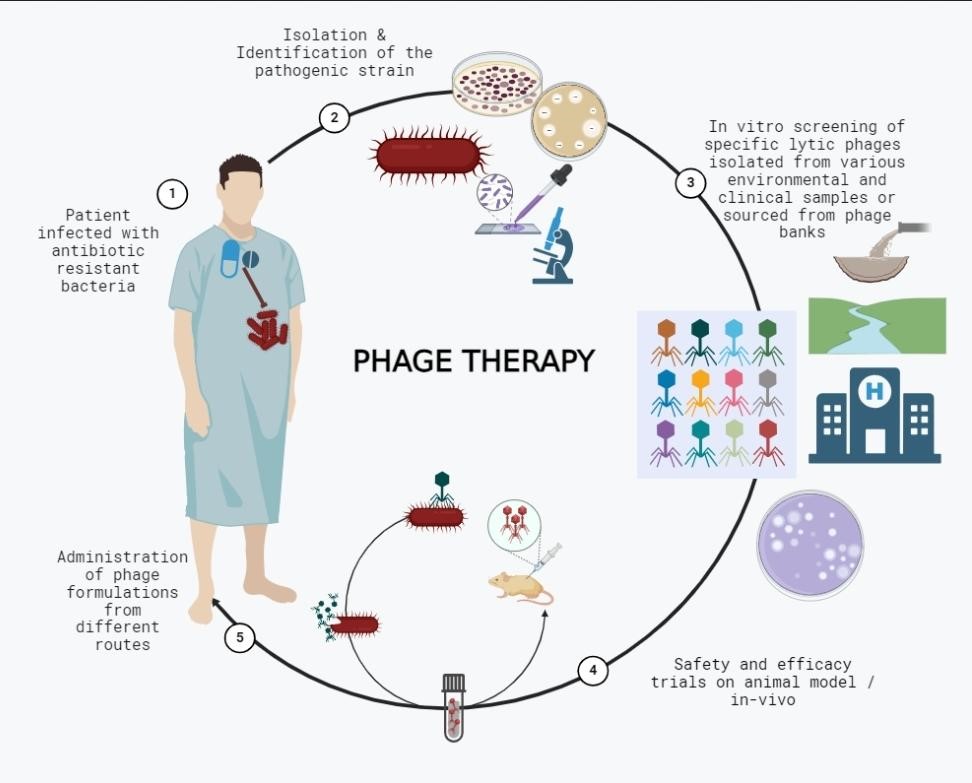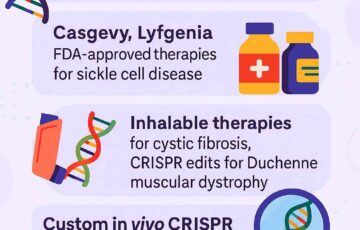Phage Theraphy: Promising Solution to Anti-Microbial Resistance
Syllabus:
GS 2:
- Issues relating to development and management of sectors like health
GS 3:
- Science and technology and its advancement
Focus:
Antimicrobial resistance (AMR) is emerging as a global health crisis. Phage therapy, involving bacteriophages, is seen as a possible solution to drug-resistant bacterial infections, offering hope for countries like India facing this threat.
Phages: Nature’s Heroes:
- Virus intervention: Phages invade bacteria, hijack their genetic material, and destroy them by replicating inside, offering a unique method to combat bacterial infections resistant to antibiotics.
- Historical use: Phage therapy was first developed in the early 20th century to treat bacterial infections like typhoid and septic wounds before antibiotics became widely used.
- Antibiotic alternative: While the West moved toward antibiotics, phage therapy continued in the Soviet Union and Eastern Europe. It is now regaining global attention as an alternative to failing antibiotics.
- Wastewater phages: Phages are naturally abundant in environments like wastewater and human excreta, suggesting a potential reservoir for identifying new bacteriophages for therapeutic use.
- Phageome balance: Phages maintain bacterial equilibrium in the human gut by targeting harmful bacteria while allowing beneficial bacteria to thrive, contributing to a balanced and healthy microbiome.
What is Antimicrobial Resistance (AMR)?
- Definition: AMR occurs when microorganisms (bacteria, viruses, fungi, etc.) evolve to resist drugs designed to eliminate them, making infections harder to treat.
- Impact: Resistant infections lead to increased disease spread, severe illness, and higher mortality rates.
- Global Threat: The World Health Organization (WHO) lists AMR as one of the top ten global health threats.
- Superbugs: Microorganisms that develop resistance to multiple drugs are often referred to as “superbugs.”
- India’s AMR Crisis: Over 56,000 newborn deaths in India are linked to antibiotic-resistant sepsis, and Covid patients with drug-resistant infections show a 50-60% mortality rate.
AMR in the Global Context:
- NDM-1: The multi-drug resistance gene New Delhi Metallo-beta-lactamase-1 (NDM-1) emerged from South Asia and has spread globally.
- Global Spread: AMR has spread beyond South Asia to Africa, Europe, and other regions, causing multi-drug resistant typhoid outbreaks.
- Hospital Infections: A study by ICMR showed that drug-resistant infections in Covid patients resulted in a mortality rate of 50-60%.
- Public Health: AMR is a significant public health concern worldwide, complicating disease management and increasing treatment costs.
- Need for Action: Global efforts are required to control AMR through better regulation, antibiotic stewardship, and research into alternative treatments.
Therapy Success Stories:
- Patrick’s recovery: Steffanie Strathdee’s husband, Patrick, survived a multi-drug resistant infection thanks to phage therapy, highlighting its potential when traditional antibiotics fail.
- Elizabeth Taylor case: Hollywood star Elizabeth Taylor recovered from a severe staphylococcal pneumonia using phage therapy during the production of Cleopatra when antibiotics proved ineffective.
- Clostridium difficile treatment: Phage therapy has shown promise in treating Clostridium difficile infections, which severely damage the colon lining, particularly after prolonged antibiotic use.
- Pseudomonas aeruginosa case: Phages entered the bacterium through its efflux pumps, forcing it to stop expelling antibiotics. This allowed the antibiotics to accumulate inside and kill the resistant bacterium.
- Global attention: Countries around the world, recognizing the rising threat of AMR, are now actively researching bacteriophages as a critical tool in combating drug-resistant bacterial infections.
Phages Versus Antimicrobial Resistance (AMR):
- Rising AMR threat: Antimicrobial resistance is predicted to cause 40 million deaths globally by 2050, making phage therapy an urgent focus to address this growing health crisis.
- Phage libraries: Countries in Eastern Europe, particularly the former Soviet Union, developed large phage libraries during the Cold War, which are now attracting renewed global interest.
- Reversing resistance: Phage therapy has demonstrated the ability to reverse antibiotic resistance by attacking bacterial cells and restoring their susceptibility to antibiotics.
- Scientific breakthroughs: Recent studies from Yale and Liverpool showed how bacteriophages could effectively target and neutralize antibiotic-resistant bacteria, such as Pseudomonas aeruginosa.
- The Indian context: India, with its vast biodiversity in land and water, has the potential to discover unique phages that could be key in fighting its rising cases of antimicrobial resistance.
Indian Efforts and Regulatory Framework:
- Bhabha Atomic Research Centre: BARC is leading India’s research in bacteriophages, looking to harness their potential for treating drug-resistant bacterial infections and advancing phage therapy research.
- Regulatory challenges: India’s regulatory framework must evolve to review, assess, and approve phage therapies for human use, ensuring safety and effectiveness before broader application.
- Scientific collaboration: Collaboration between Indian and international research institutions is essential for building a robust phage therapy system to combat antimicrobial resistance effectively.
- Compassionate use: Many countries currently allow phage therapy on compassionate grounds for critically ill patients, while regulatory frameworks evolve to accommodate these new treatments.
- Future guidelines: As research on phage therapy progresses, detailed regulatory guidelines will be needed to ensure the safe, widespread adoption of bacteriophage treatments in healthcare.
Way Forward for Phage Therapy:
- Research expansion: India must intensify its research efforts into phage therapy, leveraging its natural ecosystems to discover new phage strains that can target drug-resistant bacteria.
- Phage applications: Developing specialized phage therapies targeting specific drug-resistant bacteria could significantly reduce dependency on traditional antibiotics in treating bacterial infections.
- Public awareness: Raising awareness among healthcare professionals and the general public about the benefits and potential of phage therapy can accelerate its acceptance and use.
- Global partnerships: Strengthening partnerships with international institutions working on AMR and phage therapy will aid in the discovery and implementation of more effective treatment strategies.
- Monitoring and regulation: Establishing a regulatory system to monitor the efficacy and safety of phage therapies is vital for ensuring their successful integration into mainstream healthcare.
Conclusion:
Phage therapy holds immense potential in the global battle against antimicrobial resistance. India must expand its research and regulatory efforts to harness this life-saving technology, positioning phage therapy as a key tool in future healthcare systems.
Mains Practice Question:
Discuss the potential of bacteriophages in combating antimicrobial resistance. Analyze the challenges and opportunities in integrating phage therapy into mainstream healthcare, particularly in India.
Source: The Hindu
Associated Article:
https://universalinstitutions.com/the-grave-threat-from-antimicrobial-resistence-amr/





